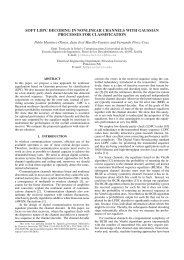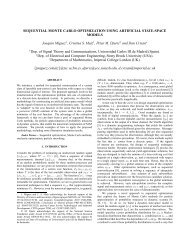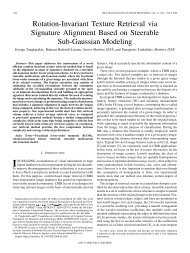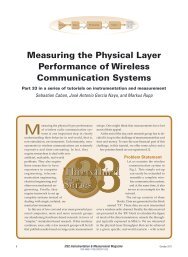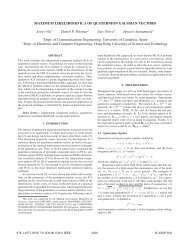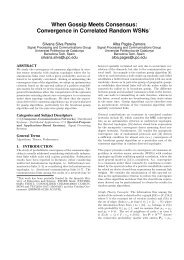The Locally Most Powerful Invariant Test for ... - COMONSENS
The Locally Most Powerful Invariant Test for ... - COMONSENS
The Locally Most Powerful Invariant Test for ... - COMONSENS
You also want an ePaper? Increase the reach of your titles
YUMPU automatically turns print PDFs into web optimized ePapers that Google loves.
2012 IEEE 7th Sensor Array and Multichannel Signal Processing Workshop (SAM)<br />
<strong>The</strong> <strong>Locally</strong> <strong>Most</strong> <strong>Powerful</strong> <strong>Invariant</strong> <strong>Test</strong><br />
<strong>for</strong> Detecting a Rank-P Gaussian Signal<br />
in White Noise<br />
David Ramírez<br />
Dept. of Electrical Engineering<br />
and In<strong>for</strong>mation Technology<br />
Universität Paderborn<br />
Paderborn, Germany<br />
Email: david.ramirez@sst.upb.de<br />
Jorge Iscar, Javier Vía<br />
and Ignacio Santamaria<br />
Dept. of Communications Engineering<br />
University of Cantabria<br />
Santander, Spain<br />
Email: {jorge, jvia, nacho}@gtas.dicom.unican.es<br />
Louis L. Scharf<br />
Depts. of Mathematics and Statistics<br />
Colorado State University<br />
Fort Collins, USA<br />
Email: scharf@engr.colostate.edu<br />
Abstract—Spectrum sensing has become one of the main<br />
components of a cognitive transmitter. Conventional detectors<br />
suffer from noise power uncertainties and multiantenna detectors<br />
have been proposed to overcome this difficulty, and to improve<br />
the detection per<strong>for</strong>mance. However, most of the proposed<br />
multiantenna detectors are based on non-optimal techniques,<br />
such as the generalized likelihood ratio test (GLRT), or even<br />
heuristic approaches that are not based on first principles. In this<br />
work, we derive the locally most powerful invariant test (LMPIT),<br />
that is, the optimal invariant detector <strong>for</strong> close hypotheses, or<br />
equivalently, <strong>for</strong> a low signal-to-noise ratio (SNR). <strong>The</strong> traditional<br />
approach, based on the distributions of the maximal invariant<br />
statistic, is avoided thanks to Wijsman’s theorem, which does<br />
not need these distributions. Our findings show that, in the low<br />
SNR regime, and in contrast to the GLRT, the additional spatial<br />
structure imposed by the signal model is irrelevant <strong>for</strong> optimal<br />
detection. Finally, we use Monte Carlo simulations to illustrate<br />
the good per<strong>for</strong>mance of the LMPIT.<br />
Index Terms—Cognitive Radio, locally most powerful invariant<br />
test (LMPIT), multi antenna spectrum sensing, Wijsman’s<br />
theorem.<br />
I. INTRODUCTION<br />
<strong>The</strong> cognitive radio (CR) paradigm is a new technology that<br />
aims to improve spectrum usage and alleviate the apparent<br />
scarcity of resources [1]. <strong>The</strong> main idea is based on the<br />
observation that there are temporally and/or geographically<br />
unused bands. Basically, CR relies on the opportunistic access<br />
of non-licensed users (secondary users) to these unused bands,<br />
avoiding interfering with rightful license owners. This translates<br />
into the need <strong>for</strong> powerful spectrum sensing (detection<br />
of primary activity) in CR networks. However, as might be<br />
expected, this is a challenging task due to shadowing and<br />
fading phenomena, as well as to the low SNR conditions.<br />
To obtain the desired per<strong>for</strong>mance in such challenging<br />
environments, spectrum sensing techniques may exploit certain<br />
features of the signals, such as cyclostationarity and/or the<br />
presence of pilots. However, those approaches usually require<br />
a level of synchronization not achievable in most practical<br />
scenarios. Hence, asynchronous detectors are of interest, the<br />
most popular being the energy detector (ED). Nevertheless, in<br />
the presence of noise power uncertainties, the per<strong>for</strong>mance of<br />
the energy detector is severely degraded [2]. To overcome this<br />
problem, and improve the detection per<strong>for</strong>mance, multiantenna<br />
detectors are typically considered. <strong>The</strong>se detectors are usually<br />
based on the generalized likelihood ratio test (see [3] and<br />
references therein), or heuristic approaches. However, it is well<br />
known that, in general, these techniques lead to suboptimal<br />
tests.<br />
In this work, we derive the locally most powerful invariant<br />
test (LMPIT) <strong>for</strong> the typical signal-plus-noise model, usually<br />
found in communication systems. Hence, we obtain the optimal<br />
invariant detector in the low signal-to-noise ratio (SNR)<br />
regime. <strong>The</strong> derivation of the LMPIT usually becomes a<br />
complicated task because we need to derive the distributions<br />
of the maximal invariant. However, using Wijsman’s theorem<br />
[4], [5], we can calculate the ratio of the distributions of the<br />
maximal invariant statistic without deriving the distributions,<br />
and even without obtaining the maximal invariant statistic. On<br />
the other hand, we must point out that the LMPIT <strong>for</strong> a closely<br />
related problem was obtained in [6], where the author used<br />
the (more complicated) conventional approach <strong>for</strong> deriving the<br />
LMPIT.<br />
II. SYSTEM MODEL<br />
We consider the problem of spectrum sensing using multiantenna<br />
spectrum monitors. <strong>The</strong> problem is <strong>for</strong>mulated in<br />
such a way that it does not require prior knowledge about<br />
the primary signals, the wireless channel, nor the noise processes<br />
(beyond spatial independence). We consider P signals,<br />
which may be generated by a P -antenna transmitter,<br />
P single-antenna users, or any combination, impinging on<br />
an L-antenna spectrum monitor. At the receiver, the signals<br />
are downconverted and sampled at the Nyquist rate, without<br />
synchronization with any potentially present primary signal.<br />
Taking this into account, the spectrum sensing problem is<br />
<strong>for</strong>mulated as<br />
H 1 : x[n] = Hs[n] + v[n], n = 0, . . . , M − 1<br />
H 0 : x[n] = v[n], n = 0, . . . , M − 1<br />
(1)<br />
978-1-4673-1071-0/12/$31.00 ©2012 IEEE 501
where s[n] = [s 1 [n], . . . , s P [n]] T is the transmitted signal,<br />
H ∈ C L×P is the wireless channel, and v[n] =<br />
[v 1 [n], . . . , v L [n]] T is the additive noise vector, which is<br />
assumed to be zero-mean circular complex Gaussian, independent<br />
of s[n], and spatially and temporally white. Moreover,<br />
the transmitted signal is considered temporally and spatially<br />
white, and the channel is flat fading. Under these assumptions,<br />
the covariance matrix of the measurements is, <strong>for</strong> all n,<br />
H 1 : R = HH H + σ 2 I,<br />
H 0 : R = σ 2 I,<br />
where σ 2 is the noise power and R = E[x[n]x H [n]].<br />
Be<strong>for</strong>e proceeding, we assume that s[n] is zero-mean,<br />
circular complex Gaussian, which will result in tractable<br />
analysis and useful detectors, and can also be seen as a worst<br />
case distribution [7]. <strong>The</strong>re<strong>for</strong>e, the detection problem in (2)<br />
becomes<br />
H 1 : x[n] ∼ CN ( 0, HH H + σ 2 I ) ,<br />
H 0 : x[n] ∼ CN ( 0, σ 2 I ) ,<br />
where CN (µ, R) stands <strong>for</strong> the complex circular Gaussian<br />
distribution with mean µ and covariance matrix R. Hence,<br />
the spectrum sensing problem has been <strong>for</strong>mulated as a test<br />
<strong>for</strong> the covariance structure of the received measurements.<br />
Specifically, under H 0 the covariance matrix is proportional<br />
to the identity matrix, whereas, under H 1 , it is the sum of a<br />
rank-P matrix and the noise covariance matrix.<br />
III. PREVIOUS WORK<br />
A. Generalized Likelihood Ratio <strong>Test</strong> (GLRT)<br />
<strong>The</strong> detection problem in (3) is a composite test, that<br />
is, the likelihoods depend on unknown parameters. Previous<br />
approaches to this problem in the context of spectrum sensing<br />
are based on the well-known generalized likelihood ratio test<br />
(GLRT), which, basically, obtains the likelihood ratio with the<br />
unknown parameters replaced by their maximum likelihood<br />
(ML) estimates. In particular, <strong>for</strong> the test given in (3), and<br />
considering M independent and identically distributed (i.i.d.)<br />
samples of x[n], the generalized likelihood ratio (GLR) is<br />
given by<br />
max p ( X; σ 2 I )<br />
σ<br />
G =<br />
2 >0<br />
max p (X; R 1 ) ,<br />
R 1=HH H +σ 2 I,<br />
σ 2 >0<br />
where the likelihood is<br />
1<br />
[ ( )]<br />
p (X; R) =<br />
π LM |R| M exp −M tr R −1 ˆR ,<br />
with |·| and tr (·) denoting the determinant and the trace of<br />
a matrix, respectively. <strong>The</strong> data matrix is given by X =<br />
[ x[0], . . . , x[M − 1]<br />
]<br />
and ˆR = XX H /M is the sample<br />
covariance matrix. Finally, the test is obtained by comparing<br />
the GLR with a threshold. In [3], it was shown that the GLRT<br />
(2)<br />
(3)<br />
depends on the rank P . For P ≥ L − 1, the test becomes the<br />
well known test <strong>for</strong> sphericity, and the GLRT is given by [8]<br />
⎡( ∏L 1/L<br />
⎤<br />
i=1 i) λ<br />
⎢<br />
log G = log ⎣<br />
1<br />
L<br />
∑ L<br />
i=1 λ i<br />
⎥<br />
⎦ H0<br />
≷ η,<br />
H 1<br />
where λ i is the i-th eigenvalue of ˆR. On the contrary, <strong>for</strong><br />
P < L − 1, the GLRT becomes [3]<br />
⎢<br />
log G = L log ⎣<br />
⎡( ∏L 1/L<br />
⎤<br />
i=1 i) λ<br />
∑<br />
1 L<br />
L i=1 λ i<br />
⎡<br />
⎢<br />
− (L − P ) log ⎣<br />
⎥<br />
⎦<br />
( ∏L 1/(L−P )<br />
⎤<br />
i=P +1 i) λ<br />
1<br />
L−P<br />
∑ L<br />
i=P +1 λ i<br />
B. <strong>Locally</strong> <strong>Most</strong> <strong>Powerful</strong> <strong>Invariant</strong> <strong>Test</strong> (LMPIT)<br />
⎥<br />
⎦ H0<br />
≷ η.<br />
H 1<br />
Despite its simplicity, the GLRT does not have any optimality<br />
property and, in fact, its per<strong>for</strong>mance might be poor<br />
when the sample size is small. <strong>The</strong>re<strong>for</strong>e, other detectors have<br />
been considered <strong>for</strong> dealing with composite hypotheses. <strong>The</strong><br />
optimal test (uni<strong>for</strong>mly most powerful test) does not exist in<br />
general, because the likelihood ratio depends on the unknown<br />
parameters. One possible way to avoid this dependence is<br />
restricting ourselves to the class of invariant detectors [9]. In<br />
this way we obtain the optimal test among those invariant,<br />
that is, the uni<strong>for</strong>mly most powerful invariant test (UMPIT).<br />
However, when the UMPIT does not exist, we can still derive<br />
an optimal test, under the assumption of close hypotheses, i.e.,<br />
the locally most powerful invariant test (LMPIT).<br />
<strong>The</strong> typical approach <strong>for</strong> deriving the LMPIT is [9]: (i)<br />
identify the invariances of the problem and describe them<br />
as a group of trans<strong>for</strong>mations, (ii) find the maximal invariant<br />
statistic, (iii) derive the distribution of the maximal invariant<br />
statistic under both hypotheses, (iv) calculate the ratio of the<br />
distributions of the maximal invariant statistic, and (v) apply<br />
a Taylor’s expansion of the likelihood ratio. 1 This approach<br />
was used in [6] to derive the LMPIT <strong>for</strong> the sphericity test<br />
H 1 : x[n] ∼ CN (0, R) ,<br />
H 0 : x[n] ∼ CN ( 0, σ 2 I ) ,<br />
with R only constrained to be a positive definite matrix. In<br />
particular, the LMPIT is given by<br />
where<br />
L = ‖ ˆ˜R‖ 2<br />
F<br />
H 1<br />
≷<br />
H 0<br />
η, (4)<br />
ˆR ˆ˜R = ( ). (5)<br />
tr ˆR<br />
1 Step (v) is only necessary if the likelihood ratio depends on the unknown<br />
parameters. Otherwise, the density ratio of the maximal invariants would<br />
provide the uni<strong>for</strong>mly most powerful invariant test (UMPIT) statistic.<br />
502
IV. DERIVATION OF THE LMPIT: WIJSMAN’S THEOREM<br />
<strong>The</strong> approach <strong>for</strong> deriving the LMPIT discussed in Section<br />
III-B might be quite complicated, not only due to the need of<br />
obtaining the distributions of the maximal invariant statistic,<br />
but also due to the need of an explicit <strong>for</strong>mulation <strong>for</strong> the<br />
maximal invariant. Here, we use another approach, namely<br />
Wijsman’s theorem [4], [5]. This theorem allows us to directly<br />
obtain the maximal invariant density ratio without knowledge<br />
of the distributions of the maximal invariant statistic, and<br />
even without an explicit expression <strong>for</strong> the maximal invariant<br />
statistic. Wijsman’s theorem states that, under some mild conditions,<br />
the likelihood ratio of the maximal invariant statistic<br />
is given by<br />
∫<br />
L = ∫ G p (g(y); H 1) |J g | dg<br />
G p (g(y); H 0) |J g | dg ,<br />
where G is the group of trans<strong>for</strong>mations under which the test<br />
is invariant, |J g | denotes the absolute value of the Jacobian<br />
of the trans<strong>for</strong>mations g(·) ∈ G, and dg is an invariant group<br />
measure.<br />
To apply Wijsman’s theorem to our problem, the first step<br />
is to identify the problem invariances. Concretely, the group<br />
of invariant trans<strong>for</strong>mations <strong>for</strong> the detection problem given<br />
in (3) is<br />
G = {g : x[n] → g(x[n]) = aQx[n]} ,<br />
where a ∈ R + is a positive real number, and Q ∈ U, with U<br />
denoting the set of unitary matrices. This means that scaling<br />
all received signals by a common factor, or multiplying them<br />
by a unitary matrix should not change the test. Taking into<br />
account the invariances of our problem, Wijsman’s theorem<br />
reads as follows<br />
L =<br />
∫R +<br />
∫<br />
U |S|2M a 2M e −a2 M tr(SQ ˆRQ H ) dQda<br />
∫R +<br />
∫U σ−2ML a 2M e − a2<br />
σ 2 M tr( ˆR)<br />
,<br />
dQda<br />
where S = ( HH H + σ 2 I ) −1<br />
. Now, to obtain the LMPIT, we<br />
have to decompose L as a function only dependent on the data<br />
and a term not dependent on the data. Be<strong>for</strong>e proceeding, let<br />
us present the following lemma.<br />
Lemma 1: <strong>The</strong> ratio L is given (up to additive and multiplicative<br />
constant terms not depending on data) by<br />
where<br />
L ∝<br />
∫R +<br />
∫<br />
α = a 2 M<br />
a 2M e −α dQda, (6)<br />
U<br />
L∑<br />
k,m=1<br />
λ k |q m,k | 2 β m .<br />
Here λ k and β m denote the eigenvalues of ˆ˜R and S, and qm,k<br />
is the {m, k}-th element of Q.<br />
Proof: <strong>The</strong> proof follows directly by simply applying the<br />
following changes of variable:<br />
( )<br />
a 2 → a 2 / tr ˆR , Q → U S QU HˆR,<br />
where U S and U ˆR<br />
are the matrices of eigenvectors of S and<br />
ˆR, respectively.<br />
It is easy to check that (6) is a function of the unknown<br />
parameters, thus proving that the UMPIT does not exist, in<br />
general. <strong>The</strong> only exception is the case of L = 2 antennas,<br />
where the test statistic of the UMPIT [10] is given by the<br />
largest eigenvalue of ˆ˜R, i.e., λ1 . Due to the non-existence of<br />
the UMPIT, we consider the challenging low-SNR scenario<br />
and derive the LMPIT. Note that in the low-SNR regime S ≈<br />
σ −2 I ⇒ α 0 = a 2 M/σ 2 , and applying a second order Taylor<br />
series expansion of e −α , we get<br />
L ∝<br />
∫R +<br />
∫<br />
a 2M e [ −α0 (α − α 0 ) 2 − (α − α 0 ) ] dQda,<br />
U<br />
Finally, the LMPIT is presented in the following result.<br />
<strong>The</strong>orem 1: <strong>The</strong> LMPIT is given by<br />
L ∝<br />
L∑<br />
k=1<br />
λ 2 k = ‖ ˆ˜R‖ 2<br />
F<br />
H 1<br />
≷<br />
H 0<br />
η. (7)<br />
Proof: Here, due to the lack of space, we only present<br />
a sketch of the proof. First, let us consider the linear term,<br />
which, neglecting the sign, may be rewritten as<br />
where<br />
∆<br />
L∑<br />
k,m=1<br />
∆ =<br />
( )<br />
λ k β m = ∆ tr ˆ˜R tr (S) = ∆ tr (S) ,<br />
∫R +<br />
∫<br />
a 2M+1 e −a2 M/σ 2 |q m,k | 2 dQda,<br />
U<br />
and we have taken into account that the value of the integral<br />
does not depend on the actual indexes. Hence, we can notice<br />
that the linear term does not depend on the data, so it can<br />
be neglected. <strong>The</strong> quadratic term, after expanding the square,<br />
becomes<br />
∑<br />
∫<br />
λ k λ l β m β s a 2M+1 e −a2 M/σ 2 |q m,k | 2 |q s,l | 2 dQda.<br />
k,m,l,s<br />
R +<br />
∫U<br />
Now, decomposing the above summations and taking into<br />
account that the value of the integral is the same <strong>for</strong> some<br />
subsets of the indexes, the proof follows.<br />
A. Further Comments<br />
This work has derived the LMPIT using a (in our opinion)<br />
more powerful approach, Wijsman’s theorem, whereas [6] uses<br />
the conventional approach, requiring an explicit <strong>for</strong>mulation of<br />
the maximal invariant statistic and its distributions. Moreover,<br />
[6] did not consider the additional spatial structure imposed by<br />
the signal-plus-noise model. From our results, we can conclude<br />
that in the low-SNR regime the additional structure imposed<br />
by the signal model given in (1) and the hypothesis test in<br />
(3) is irrelevant <strong>for</strong> optimal detection. On the contrary, it is<br />
known that the GLRT depends on the spatial structure of the<br />
measurements under H 1 .<br />
503
Probability of Detection<br />
1<br />
0.8<br />
0.6<br />
0.4<br />
0.2<br />
GLRT<br />
LMPIT<br />
Probability of Detection<br />
1<br />
0.8<br />
0.6<br />
0.4<br />
0.2<br />
GLRT<br />
LMPIT<br />
0<br />
10 20 30 40 50<br />
L<br />
0<br />
−20 −15 −10 −5 0<br />
SNR (dB)<br />
Fig. 1. Probability of detection vs. L <strong>for</strong> P = 30, M = 50, p fa = 0.1<br />
and SNR = −6 dB.<br />
Fig. 2. Probability of detection <strong>for</strong> p fa = 0.1, L = 40, P = 30 and<br />
M = 40.<br />
V. NUMERICAL RESULTS<br />
In this section we evaluate the per<strong>for</strong>mance of the LMPIT<br />
by means of Monte Carlo simulations. <strong>The</strong> noise power σ 2<br />
is fixed during the experiment, and the entries of the channel<br />
matrix are i.i.d. complex Gaussian random variables scaled to<br />
achieve the same SNR per realization, with the SNR defined<br />
as follows<br />
SNR (dB) = 10 log 10<br />
tr ( HH H)<br />
Lσ 2 .<br />
In the first experiment, we obtain the probability of detection<br />
<strong>for</strong> a fixed false alarm probability (p fa = 0.1) and varying L,<br />
the remaining parameters are P = 30, M = 50 samples and<br />
SNR = −6 dB. Figure 1 shows that the per<strong>for</strong>mance of the<br />
LMPIT is better than that of the GLRT, and these differences<br />
are greater <strong>for</strong> large values 2 of L.<br />
<strong>The</strong> second experiment analyzes the per<strong>for</strong>mance of the<br />
GLRT and the LMPIT <strong>for</strong> different values of the SNR. Figure<br />
2 shows the probability of detection <strong>for</strong> a fixed probability of<br />
false alarm p fa = 0.1, L = 40, P = 30 and M = 40. As<br />
expected, the per<strong>for</strong>mance of the LMPIT is better <strong>for</strong> these<br />
small to moderate values of the SNR.<br />
VI. CONCLUSIONS<br />
We have derived the locally most powerful invariant test<br />
(LMPIT) <strong>for</strong> a spectrum sensing problem in cognitive radio.<br />
That is, we have obtained the optimal invariant test in the low<br />
SNR regime. Interestingly, it turns out that the LMPIT coincides<br />
with a previously proposed LMPIT <strong>for</strong> a closely related<br />
problem, where the covariance matrix under the alternative is<br />
only constrained to be positive definite. Hence, this work has<br />
proved that the actual spatial structure of the covariance matrix<br />
under the true hypothesis is irrelevant <strong>for</strong> optimal detection<br />
in the low-SNR region, contrary to the GLRT, which tries<br />
2 In a practical scenario, it is impossible to have a spectrum monitor with<br />
such a large number of antennas, but it might be possible to use several<br />
cooperative spectral monitors to achieve such a large number.<br />
to exploit that in<strong>for</strong>mation. Additionally, we have followed<br />
an alternative approach <strong>for</strong> deriving the LMPIT, based on<br />
Wijsman’s theorem, which overcomes the need <strong>for</strong> deriving<br />
the distributions of the maximal invariant statistic. Finally, as<br />
expected, simulation results illustrate the better per<strong>for</strong>mance<br />
of the LMPIT <strong>for</strong> small to moderate values of the SNR.<br />
ACKNOWLEDGMENTS<br />
<strong>The</strong> work of J. Iscar, J. Vía and I. Santamaría was<br />
supported by the Spanish Government, Ministerio de Ciencia<br />
e Innovación (MICINN), under projects COSIMA<br />
(TEC2010-19545-C04-03) and <strong>COMONSENS</strong> (CSD2008-<br />
00010, CONSOLIDER-INGENIO 2010 Program). <strong>The</strong> work<br />
of L. L. Scharf was supported by the Air<strong>for</strong>ce Office of<br />
Scientific Research under contract FA9550-10-1-0241.<br />
REFERENCES<br />
[1] J. Mitola and G. Q. Maguire Jr., “Cognitive radio: Making software<br />
radios more personal,” IEEE Pers. Comm., vol. 6, pp. 13–18, Aug. 1999.<br />
[2] R. Tandra and A. Sahai, “SNR walls <strong>for</strong> signal detection,” IEEE J. Sel.<br />
Topics Signal Process., vol. 2, no. 1, pp. 4–17, Feb. 2008.<br />
[3] D. Ramírez, G. Vázquez-Vilar, R. López-Valcarce, J. Vía, and I. Santamaría,<br />
“Multiantenna detection of rank-P signals in cognitive radio<br />
networks,” IEEE Trans. Signal Process., vol. 59, no. 8, pp. 3764–3774,<br />
Aug. 2011.<br />
[4] R. A. Wijsman, “Cross-sections of orbits and their application to<br />
densities of maximal invariants,” in Proc. Fifth Berkeley Symp. on Math.<br />
Stat. and Prob., vol. 1, 1967, pp. 389–400.<br />
[5] J. Gabriel and S. Kay, “Use of Wijsman’s theorem <strong>for</strong> the ratio of<br />
maximal invariant densities in signal detection applications,” in Asilomar<br />
Conf. Signals, Systems and Computers, vol. 1, Nov. 2002, pp. 756 – 762.<br />
[6] S. John, “Some optimal multivariate tests,” Biometrika, vol. 58, no. 1,<br />
pp. 123–127, 1971.<br />
[7] J. Villares and G. Vázquez, “<strong>The</strong> Gaussian assumption in second-order<br />
estimation problems in digital communications,” IEEE Trans. Signal<br />
Process., vol. 55, no. 10, pp. 4994–5002, 2007.<br />
[8] J. Mauchly, “Significance test <strong>for</strong> sphericity of a normal n-variate<br />
distribution,” Ann. Math. Statist., vol. 11, pp. 204–209, 1940.<br />
[9] L. L. Scharf, Statistical Signal Processing: Detection, Estimation, and<br />
Time Series Analysis. Addison - Wesley, 1991.<br />
[10] O. Besson, S. Kraut, and L. L. Scharf, “Detection of an unknown rankone<br />
component in white noise,” IEEE Trans. Signal Process., vol. 54,<br />
no. 7, pp. 2835–2839, Jul. 2006.<br />
504



